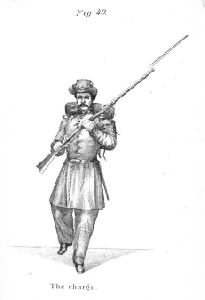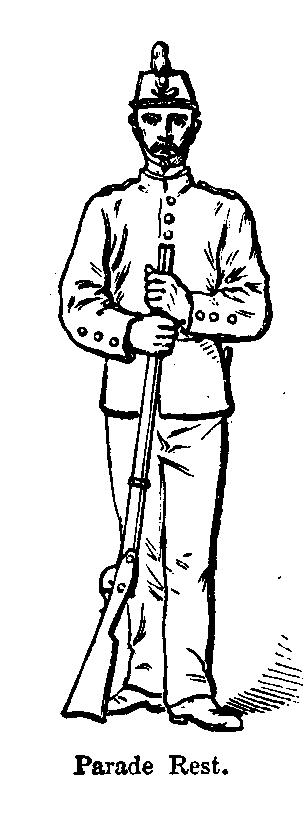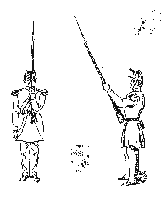When in the field, the officers and men of the ARMY OF THE PACIFIC are asked to follow the "Regulations" set forth below. Military organization and duties are vital to the efficient functioning, safety and tactical superiority of the battalion. Other guidelines will be published as needed.
I. Camp Duties
Companies are expected to share in required duties. The Adjutant will
ensure that the duties are fairly divided among the companies. Companies
will provide details when necessary for:
1. Pickets and Camp Guards (Guard will generally be mounted all night long);
2. Details and Patrols;
3. Fatigues;
4. Any other duties necessary for the safety or functioning of the battalion.
Officers and NCOs are expected to be familiar procedures for Guard Mount, and general duties of sentinels. Such may be found in Dal Bello's Instructions for Guards and Pickets.
II. Camp Life
- Reveille will be sounded at 6:00 am or other time designated by the battalion commander or higher authority. Companies will form in their company streets/areas for roll call. At least one company officer will be present at roll calls.
- There should be at least 3 roll calls
per day: Reveille, Retreat, Tattoo.
- From Kautz:
- Each 1st Serg't. will prepare his Morning Report, have the Co. commander sign it, and turn it into to the Adjutant's office by 8:00 am, or other time specified by the Adjutant. Other reports will be submitted as required. All necessary forms will be provided by the Adjutant's office.
- There shall be at least one Battalion Parade, daily, unless dispensed with.
- On all duties, except fatigues, troops will appear with trousers unbloused, and all buttons buttoned, unless directed/permitted otherwise (the Regulations say that the coat is to be "hooked and buttoned," - this must be more than just the "top button").
- Officers and men are expected to be with the battalion at all times, unless excused. Company officers will inform the Adjutant when they shall be absent from their commands, and who in the company is in charge during their absence.
- All men and company officers will be housed in shelter halves; field and staff officers in common-tents or flies. At times, other tentage may be appropriate.
- Quiet will be observed in the camp at 11:00 pm.
- If cheering, please cheer "Hurrah!" Research done by this author and Bob Braun indicates "Hurrah" was much more used than "Huzzah." ("Our Union forever, Hurrah, boys, Hurrah!" (See Dal Bello's "Three Cheers and a Tiger," in a past The Long Roll, and the Camp Chase Gazette, July?, 1995).
427. ... If the company is forming without arms, the men fall in and take the position of parade rest, ... . 428. They should fall in in two ranks, whether with or without arms. With arms they fall in at a shoulder arms ... The company is formed between the musician's call and the last note of the assembly [Reveille]. 429. When the music has ceased, the first sergeant commands, "Attention!" ... and if with arms ... "Support Arms." The roll is then called ... . As each name is called, they answer , "Here," and if at a support, they come to a "shoulder," and finally to "order arms," immediately after answering.
III. Drill
Colonel Dal Bello is the author
of a manual on battalion evolutions. Thus, his battalions are expected
to drill and maneuver well on the field. This requires study on the part
of the field officers, captains, subalterns and sergeants (the pressure
is on). It is upon these men that the success of battalion movements lies
- don't expect to learn/see these for the first time on the drill field
- study beforehand.
The importance of drill is to enable the men to work together, provide discipline and safety, and empower the battalion to function on the battlefield as an effective force. The battalion commander will attempt to run the battalion drills as efficiently as possible. To that end, we will endeavor to have "schools" for officers and NCOs before we actually go on the drill field. None of us wants to be embarrassed, and we do not want the men to be standing around waiting for the "bugs" to figure out what they are doing. A short but good drill is much better than a long and mediocre one.
Important Maneuvers to Study:
- 1. Forming the battalion (see THE LONG ROLL, No. 10; AoP handout; or PIE).
- 2. Breaking from line into column of companies. Wheeling, By the right of companies to the rear, by the flank.
- Forming column doubled on the center; column of divisions.
- Deploying into line. Left into line; On the right into line; Forward into line.
- Maneuvering in Column.
- Maneuvering in Line of Battle. Forward, Changing Front, Obstacles.
- By the right of companies to the rear/front. For maneuvering in trees, through gun lines, &c.
- Skirmishing, especially the flank companies. Flankers, Advanced/Rear Guard duties.
A reference is Dal Bello's Parade, Inspection, and Basic Evolutions of the Infantry Battalion (PIE). It is a highly recommended manual in such organizations as the Western Brigade and the Breckinridge Battalion.
IIII. Recommended Books
It is important to know the Schools of the Soldier and Company, and the
Skirmish drill. The necessary administrative, Guard and fatigue duties
should also be studied. Officers and sergeants should study battalion
drills.
- Casey's Infantry Tactics, 1862;
- Dal Bello's Instructions for Guards and Pickets, 1996;
- Dal Bello's Parade, Inspection and Basic Evolutions of the Infantry Battalion, "PIE," 4th Ed, 1998.
- Hardee's Rifle and Light Infantry Tactics, 1855 (1861);
- Kautz's Customs of Service for Non-Commissioned Officers and Soldiers, 1864 - a "how to" on being a soldier and NCO;
- United States Army Regulations, 1861;
- United States Infantry and Rifle Tactics, 1861.
V. Drill Bits
- The ARMY OF THE PACIFIC shall drill by the 1861 United States Infantry and Rifle Tactics (Hardee's without his name) and Casey's 1862 Infantry Tactics. Such battalion manuals are summarized in Dal Bello's "PIE." Shouldered Arms is as per the light infantry drill.
- All men shall be drilled in the loadings at every event. In summer '97, I observed three incorrect and unsafe loadings in one minute; even with this reminder, I noted 2 incorrect loadings within seconds at Antietam. We should not take this for granted. First pour the powder, then lift the hammer and replace the cap. Safety IS written into the tactics - if you remove the cap first, air allowed into the vent keeps sparks in the barrel alive. Do not place paper in the muzzle. Half-cock is safer than letting the hammer down on the cap.
- Arms will be stacked per the "Musket Stack" as given in Scott's 1835 Infantry Tactics, School of the Soldier, Para. 415 and Casey's Infantry Tactics, SoS, Para. 425. While the "Ellsworth (Kentucky) Swing" was used by some Federal units, the Musket Stack was the only one authorized for the shank-bayonet by the central authority.
- Parade Rest will be as per "Hardee's"/"Casey's" (across the body), as shown at right (from Upton's). That given in the U.S. Army Regulations will not be used.
- There will be NO echoing of commands. If the battalion commander can be heard, there is no reason to echo him and step on his next command. Plus, it looks/sounds ridiculous - the enemy can hear you. According to Hardee's/Casey's "School of the Battalion," the only commands that are repeated are those of "March" and "Halt" (by the co. commanders) and only in a column of companies, so that they move and halt at the same time (to preserve wheeling distance). Of course, in battle, and on the skirmish line, it becomes necessary to repeat commands that are not heard over the noise/distance. And, at times the company commander must give a preparatory command to his own company, or caution it to make some movement. In general, DO NOT ECHO COMMANDS. For now, if the Colonel cannot be heard, commands will be repeated by the wing commanders; and if necessary, by the Adjutant and Serg't. Major.
- No gesturing of officers' swords is necessary or desired. Field officers may use gestures needed to maneuver and align the battalion (to indicate points, &c). Company officers will not use their swords to signal marching movements or arms movements; they are not drum-majors. Officers should carry their swords at the Carry (shoulder) while at drill or on the march; or at their pleasure (in the scabbard is fine) while at the route step. At double quick, the sword should be angled to the left, the tip in front of the left shoulder. See Walden, Geoff, "A Manual of the Sword for Foot Officers," Camp Chase Gazette, Vol. 24, No. 1, October 1996, pp. 34-39.
- File closers need not remain constantly at Shouldered Arms. This seems to be a long-standing reenacting misconception of the "Sergeants Manual." File closers, including the 1st Serg't., should follow the commands for arms movements the same as the men in the ranks.
- On the march (when the battalion is marching to the step), the battalion commander will generally indicate to the leading company commander that "You may change arms (positions) at your discretion, Mr. _____" (e.g., from Shouldered Arms to Right Shoulder Shift, &c.). After the first company changes arms positions, the second company will follow suit, then the third, &c. Thus, arms will be changed in a "rippling manner." This is the same idea from when the battalion is on Parade - the companies come to Parade Rest from right to left.
- During each significant halt on the march, and after every battle, the 1st Serg't. will call the Roll and all men shall be accounted for.
- In drill, and in the field (unless under fire), markers, company guides, and general guides will be utilized. Thus, SERGEANTS AND OFFICERS MUST KNOW (at least STUDY) THEIR DRILL.
- In making a charge - CLOSING WITH ENEMY - the battalion will first come to Arms-Port, as per research done by this author (see Scott's 1830 Abstract of Infantry Tactics; period images of lines closing). The front/rear rank will not go to charge bayonet/right shoulder shift. For safety, the front rank will remain at Arms Port if we actually come into contact (in reality, it is when the lines meet that the front rank comes to charge bayonet; the rear rank remains ready at arms port to assist the front rank as needed). Such a charge should take place only when closing with the enemy is expected. See figure "The Charge" (from Kelton's 1862 Manual for the Bayonet).
- When counting off - "In each rank count - TWOS," the men do not need to yell, but state their number in a firm voice. The enemy can hear too many reenacting units counting off.
- Casualties. "...Files having been formed, as often as a front ... rank man falls or steps out of his rank, he will be immediately replaced, for the time, by his coverer in the next rank" [Scott, 1835, Vol. I, SoS, Para. 16]. If there is a casualty, step up. This (1) keeps the front rank men from crossing in front of the rear rank (safety), (2) retains the numbers (temporarily; a fortuitous result as doubling was not in "Scott's"), and (3) the battalion keeps its length in the line (and distance between battalions). If large gaps are created, the officers/file closers should see that they are filled.
- It's "By file right (left)," not "By files..."
- Presenting the piece for Inspection will be as at right (from Baxter's 1861 The Volunteer's Manual, and the 1861 U.S. Infantry Tactics).

|
|
|
|
Parade Rest |
Inspection Arms
(left, Baxter; right, US Infantry and Rifle Tactics) |
"This is a painting of the charge of the 5th NY at Gaines Mill by John K. Finch of Company G, who was wounded there. You will note that he shows the death of Capt. Partridge of Co. I..... notice "Arms Port" is the way they are advancing. I do not think Finch would have gotten that wrong" - Brian Pohanka, in an email to Scott Harrington, both of the 5th NY (reenacting unit).


